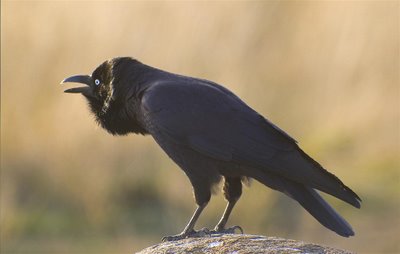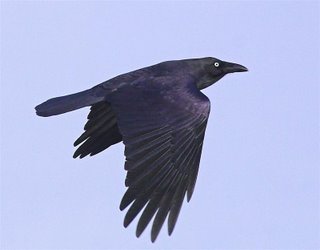 As a few may remember, I have been trying to get better shots of Forest Ravens, and today, in two different venues, I managed to make some improvement. While processing the shots, I realised that far from being black, seen in the right light, they're a rather nice, shiny, dark royal blue. For some time I believed, wrongly, that they were a Tasmanian endemic, perhaps the latin name corvus tasmanicus suggested that. I can recall photographing a very co-operative 'crow' on Wilson's Promontory some years back. It looked
As a few may remember, I have been trying to get better shots of Forest Ravens, and today, in two different venues, I managed to make some improvement. While processing the shots, I realised that far from being black, seen in the right light, they're a rather nice, shiny, dark royal blue. For some time I believed, wrongly, that they were a Tasmanian endemic, perhaps the latin name corvus tasmanicus suggested that. I can recall photographing a very co-operative 'crow' on Wilson's Promontory some years back. It looked  all too familiar and it was! Other populations are found in The Otways and North Eastern NSW. If it's as successful on the Mainland as here in Tasmania, the population could be expected to expand. Forest Ravens can be found virtually anywhere in the state. Their ID is made easier by being the only 'crow' found throughout Tasmania, with the exception of King Island, which they share there with the commoner Little Raven.
all too familiar and it was! Other populations are found in The Otways and North Eastern NSW. If it's as successful on the Mainland as here in Tasmania, the population could be expected to expand. Forest Ravens can be found virtually anywhere in the state. Their ID is made easier by being the only 'crow' found throughout Tasmania, with the exception of King Island, which they share there with the commoner Little Raven.I assume, the bird at top, is making a territorial statement, or perhaps advertising for a mate, as it appeared to be alone. It was photographed at the lookout on top of Rosny Hill, in the late afternoon sun.
6 comments:
Hi Alan,
I really like your shot of the Raven calling for a mate, or whatever it was doing. We used to live in NE NSW, and can't be sure that we didn't see Forest Ravens then, though we weren't looking specifically for them, so can't be sure we did, either. HAving just visited NSW again recently, the call of the Australian Raven seems very high, thin, and "whimpy" after the deep baritone of our own 'tasmanicus'. Unfortunately, when we lived on the Northern Tablelands, we were more concerned with distinguishing Torresian Crows and Little Ravens, so weren't listening carefully enough for the rich Baritones we have now come to be familiar with. I have read where the most common Corvid between Armidale and Coffs Harbour (a little out of our earlier range) tends to be the Forest Raven. Much easier here, where there is only the one to choose from.
Thanks for your comments John. I took quite a few shots, but this one captured, for me, something of the essence of the bird. No wonder myths and believes thrived in earlier times about crows and ravens in general.
They certainly are a cunning, intelligent bird, with a lot of personality. Despite all the crows and ravens I've seen feeding on road-kill, I don't think I've ever seen one of THEM as road-kill!!
You don't know how easy things are in Tasmania until you move to NSW and have five corvids to tell apart! Something I have not mastered. Antway, when I read up on the Northern NSW race of Forest Raven ( the so called 'Relict Raven')one of the distinguishing features mentioned in books is that the tail gets pointed downwards as they call. Your photo suggests the Tasmanian ones do the same thing. Do you think that's right? Food for thought.
I shall have to watch one more closely when it's calling - can't say I've noticed. Around Tenterfield and Boggabilla, we found the flicking of the wings while calling quite distinctive of the Little Raven, and the kind of 'warbling' of the Torresian Crows also very helpful. As I said earlier, we never positively ID 'Forest' or 'Relict' Ravens in NSW
They do indeed drop their tails as they call. I have been watching one calling in a neighbour's tree for the last cople of mornings, and they seem to both raise their wings AND drop the tail with each throaty "Caw". It will be interesting to hear whether the mainland "Relict" Raven does the same!
Post a Comment